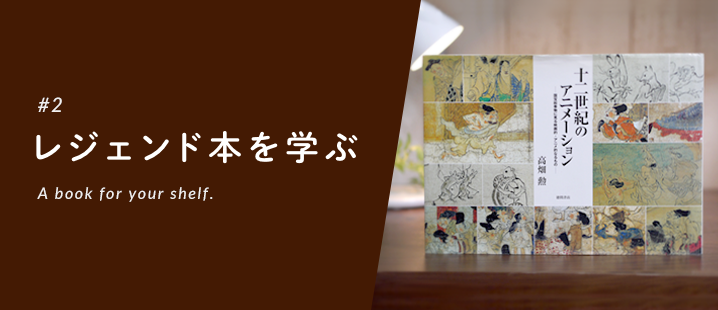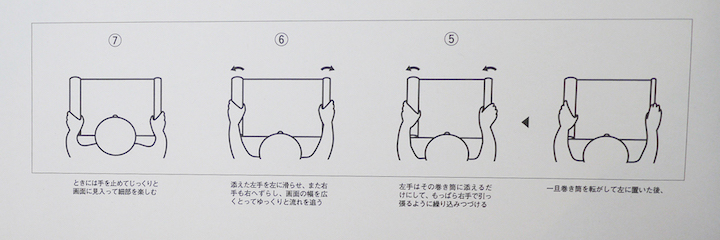アニメは850年続く日本の文化! 『十二世紀のアニメーション』〜レジェンド本を学ぶ

「レジェンド本を学ぶ」は、イラスト、アニメ、漫画、映像など、さまざまな分野のレジェンドクリエイターの著書から作品や表現について学ぶことで、創作をより深く広く楽しんでいただくためのコーナーです。
第二回となる今回は、高畑勲監督の『十二世紀のアニメーション―国宝絵巻物に見る映画的・アニメ的なるもの―』をご紹介します。
高畑勲監督といえば『火垂るの墓』(1988)や『平成狸合戦ぽんぽこ』(1994)、『かぐや姫の物語』(2013)などを手掛けた、日本アニメ界のレジェンド中のレジェンドです。かの宮崎駿は彼の東映動画(現・東映アニメーション)時代の後輩にあたります。
映画監督としての活躍が目立つ方ですが、『ルパン三世 』(TV第1シリーズ/1971)や『アルプスの少女ハイジ』(1974)、『未来少年コナン』(1978)など、TVアニメシリーズの演出として敏腕をふるい、その後のアニメ業界に多大な影響を与えた方でもあります。
今回はそんな高畑監督の著書『十二世紀のアニメーション―国宝絵巻物に見る映画的・アニメ的なるもの―』を紐解きながら、アニメや漫画と同じエンターテインメント表現がはるか昔から日本にあったこと、そして漫画やアニメが、それを正当に受け継いだ「日本の文化」であることについて学んでいきましょう。
"850年続く"って、どういうこと?と感じた方も多いのではないでしょうか。
実は、日本のアニメには、私たちが思っているよりはるかに長い歴史があるのです。
実は、日本のアニメには、私たちが思っているよりはるかに長い歴史があるのです。
文:いしじまえいわ
日本のアニメはいつ始まった?
ところで、日本のアニメはいつから始まったのか、みなさんご存知でしょうか。
詳しい方でしたら「1963年の『鉄腕アトム』が最初だ」と言うかもしれません。たしかに、現在私たちが親しんでいるTVアニメのフォーマットはこの作品によって生まれたので、1963年という答えも間違いではないでしょう。
詳しい方でしたら「1963年の『鉄腕アトム』が最初だ」と言うかもしれません。たしかに、現在私たちが親しんでいるTVアニメのフォーマットはこの作品によって生まれたので、1963年という答えも間違いではないでしょう。
またある人は、1917年と答えるかもしれません。これはフィルムが現存する日本最古のアニメ映画『なまくら刀』が公開された年です。
この解釈ですと、来年がちょうどアニメ生誕100周年にあたります。これを記念して、現在、株式会社アニプレックスの代表取締役・植田益朗氏が中心となり「日本のアニメーション100周年プロジェクト」を企画されています。
もうすぐ1世紀、だいぶ重みのある歴史ですね。
この解釈ですと、来年がちょうどアニメ生誕100周年にあたります。これを記念して、現在、株式会社アニプレックスの代表取締役・植田益朗氏が中心となり「日本のアニメーション100周年プロジェクト」を企画されています。
もうすぐ1世紀、だいぶ重みのある歴史ですね。
ですが、高畑勲監督は、アニメの歴史はそれよりもずっと前の十二世紀、西暦でいえば1100年代、約850年前までさかのぼれると説いています。
それはなぜかというと、当時の絵巻物に、「現在のアニメのルーツとなる表現方法」を見いだせるからです。
とはいえ、なぜ静止画であるはずの絵巻物が、映像であるアニメのルーツになるのでしょう? まずはそこからご紹介していきたいと思います。
それはなぜかというと、当時の絵巻物に、「現在のアニメのルーツとなる表現方法」を見いだせるからです。
とはいえ、なぜ静止画であるはずの絵巻物が、映像であるアニメのルーツになるのでしょう? まずはそこからご紹介していきたいと思います。
アニメと漫画の共通点
絵巻物とアニメの関連を探る前に、まずよりイメージが近い、静止画である漫画との共通点について見てみましょう。
高畑監督は本書のなかで以下のように指摘しています。
高畑監督は本書のなかで以下のように指摘しています。
アニメや漫画は「おもに輪郭線と色面で描かれたさまざまな絵をならべ、それに言葉をそえて、時間とともに、お話をありありと語ったもの」。これはかなり的確に両者の特徴と共通点を言い当てているように思えますね。
そして、この特徴が12世紀の絵巻物にも同じく当てはまる、と高畑監督は指摘しているのです。
絵巻物はかつての映像表現?
ところでみなさん、「絵巻物」が何なのかはご存知でしょうか? 縦長のトイレットペーパーのような、筒に丸められた紙で、しゅるしゅると引っ張って伸ばして見る、あれです。忍者漫画などにはよく登場するので、ご存知の方も多いかもしれませんね。
では、その開き方が二通りあることはご存知でしょうか?
では、その開き方が二通りあることはご存知でしょうか?
ひとつ目の方法は、巻物を肩幅程度に開き、絵を堪能したら右手で筒を巻き取って一度閉じ、改めて左側を開いて見る。これを繰り返すという方法です。

(『十二世紀のアニメーション』p.13より引用)
この方法には、巻物を少しずつ巻き取っていくことで、巻物が上下にずれることが少なく、歴史的価値のある絵巻物を傷めにくいという利点があります。高畑監督によると「現在の美術館学芸員や先生方の扱い」(p.12)だそうです。
ただこの方法だと、開いて、閉じて、見て、を繰り返すので、基本的には都度静止画を見るのと変わりありません。
ただこの方法だと、開いて、閉じて、見て、を繰り返すので、基本的には都度静止画を見るのと変わりありません。
もうひとつの方法は、左手は添えるだけにし、右手で巻物をどんどん巻き取りながら、さながらトイレットペーパーをどんどん引っ張っていくかのように見るという方法です。

(『十二世紀のアニメーション』p.13より引用)
この方法の場合、巻き取る際に端が徐々にずれていってタケノコ状になってしまうことがあり、絵巻物を傷めてしまうおそれがありますが、絵がスライドしていくことで、映像と同様、カメラや被写体が動いているかのような視覚体験ができるのです。
高畑監督は、現在貴重な資料保存のため滅多にできなくなったこの見方こそ、絵巻物の本当の見方であるとしています。
高畑監督は、現在貴重な資料保存のため滅多にできなくなったこの見方こそ、絵巻物の本当の見方であるとしています。
連続的に画面を進展させると、絵は左手のなかから現れ、眼前を右へと流れ、右手のなかへと消えていく。それはあたかもカメラが左へと移動やパンをしたときと同じように見える。しかも、移動の速さも視野の広さも、内容に応じ時に応じ、自在に変えることができるのである。
(『十二世紀のアニメーション』p.13より引用)
(『十二世紀のアニメーション』p.13より引用)
また、国宝として日本四大絵巻物に数えられる『信貴山縁起絵巻(しぎさんえんぎえまき)』については、以下のように評しています。
この作品の驚くべき特質は、見進むにつれて、すっかり絵物語の世界のなかに没入・同化してしまえるところにある。それはまさに映画の革命的特質とされ、映画以前にはあり得なかったと考えられてきたものだった。
(『十二世紀のアニメーション』p.13より引用)
(『十二世紀のアニメーション』p.13より引用)
映画的な没入感のある、絵で描かれた映像……まさにアニメですね。
このように、絵巻物は静止画の連続として見るのではなく、どんどん絵をスライドさせて見ることによって、動き=時間の流れを表現した、映画的・映像的メディアだったのです。
また、この"時間の流れを表現できる"という特徴により、絵巻物は漫画やアニメと同じ「おもに輪郭線と色面で描かれたさまざまな絵をならべ、それに言葉をそえて、時間とともに、お話をありありと語ったもの」と言うことができます。
これが、高畑監督が絵巻物に漫画やアニメの表現のルーツを見出す理由なのです。
これが、高畑監督が絵巻物に漫画やアニメの表現のルーツを見出す理由なのです。
意外なところにあった! 現代の絵巻物
ちなみに、「物語を繰り広げる」「人間ドラマが繰り広げられる」という表現がありますが、この「繰り広げる」という言葉は「絵巻物を繰り(=巻き)広げる」ということに由来しています。高畑監督の言う通り、絵巻物が漫画やアニメや映画と同じく物語を表現するものであると思えてきますね。
また、お気づきの方もいると思いますが、上記の高畑監督の指摘する絵巻物の繰り広げ方……縦か横かの違いはあるものの、パソコンでWebサイトなどをスクロールする動きにとてもよく似ています。この「スクロール(scroll)」という英語の動詞も、語源は「巻物」という名詞です。
絵巻物が単に静止画を巻いたものではなく、スクロールして見るためのものと考えれば、絵巻物が動きを活用し時間の流れや変化を表現するメディアであると理解しやすいのではないでしょうか。
(スマホ向けの縦スクロール漫画などは、絵巻物の直系の子孫と言えるかもしれません)。
(スマホ向けの縦スクロール漫画などは、絵巻物の直系の子孫と言えるかもしれません)。

(中略)さらに、漫画とアニメの共通点はもうひとつあります。それは、どちらも、時間とともに見進むように作られていることです。
(中略)すなわち、日本の漫画やアニメは、「おもに輪郭線と色面で描かれたさまざまな絵をならべ、それに言葉をそえて、時間とともに、お話をありありと語ったもの」ということができます。
(『十二世紀のアニメーション』p.4より引用)